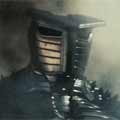Standard rings on a picatinny tail instead of action, why?
22 posts
• Page 1 of 1
Re: Standard rings on a picatinny tail instead of action, wh
They are probably mounting them on picatinny rails for the extra adjustment that they can allow, such as a 20MOA rail etc, although many rifles come with them as a standard accessory.
Taking a 20MOA rail as an example, it basically angles the front of the scope down towards the muzzle which provides an extra 20MOA of downwards adjustment to your line of sight when shooting at longer ranges.
Taking a 20MOA rail as an example, it basically angles the front of the scope down towards the muzzle which provides an extra 20MOA of downwards adjustment to your line of sight when shooting at longer ranges.
-

WesleySnipes - Lance Corporal

- Posts: 140
- New South Wales
Re: Standard rings on a picatinny tail instead of action, wh
" but if you're only using a pair of rings and a scope what's the point?"
because it's tacticool!
unless you're changing scopes on a regular basis i agree, i can't see the point. i have a 20moa pic rail on one gun for long range shooting otherwise i just use rings that fit the dovetail on my guns
Chronos
because it's tacticool!
unless you're changing scopes on a regular basis i agree, i can't see the point. i have a 20moa pic rail on one gun for long range shooting otherwise i just use rings that fit the dovetail on my guns
Chronos
-

Chronos - Second Lieutenant

- Posts: 2082
- New South Wales
Re: Standard rings on a picatinny tail instead of action, wh
Chronos wrote:because it's tacticool!
Gotta attach as many black notched things as possible!!!
TIKKA T3 TAC .300 WIN MAG
HOW SPORTER 270 WIN
HOWA YOUTH .204 RUGER
MARLIN 1889 .38-40
HOW SPORTER 270 WIN
HOWA YOUTH .204 RUGER
MARLIN 1889 .38-40
-

ebr love - Corporal

- Posts: 306
- New South Wales
Re: Standard rings on a picatinny tail instead of action, wh
Picatinny rails are more popular overseas where they don't have the same restrictions we do.
For example, for guys in the US where AR-15's and similar style rifles are so popular and all have 1 or more rails making rings for that system makes sense.
Not everything comes with dovetail mounts...
For example, for guys in the US where AR-15's and similar style rifles are so popular and all have 1 or more rails making rings for that system makes sense.
Not everything comes with dovetail mounts...
-

Yelp - Lance Corporal

- Posts: 223
- Queensland
Re: Standard rings on a picatinny tail instead of action, wh
For any hunting rifle there is no need.
For a target rifle I'd say the same in the majority of cases. Unless you're shooting particularly long range where you need that extra elevation adjustment for when drop really starts increasing.
For a target rifle I'd say the same in the majority of cases. Unless you're shooting particularly long range where you need that extra elevation adjustment for when drop really starts increasing.
-

Skadoo - Lance Corporal

- Posts: 103
- South Australia
Re: Standard rings on a picatinny tail instead of action, wh
chulley wrote:Hey guys,
Question on mounting scopes here.
I see a few rifle setups where instead of just mounting the scope on the receiver or on standard mounts guys add a picatinny rail, by then just add standard rings to the rail.
A rail will accept a lot of stuff, but if you're only using a pair of rings and a scope what's the point? Not everyone's attaching lasers and that.
Just seems like extra junk on the rifle for no reason?
There are a few points here that haven't been mentioned and Picatinny Rails are not really for mounting Lasers, not really just because they look Tacticool etc unless you refer to the rails that are all over a rifle, down the front and sides etc.
The Rings that fit a Picatinny Rail are not ordinary Rings. They are not the same size as those that attach to a Dovetail. There are two types of Rails and both are different dimensions. First you have a Weaver Rail then you have a Picatinny Rail which is actually a MIL-STD-1913 Rail and the Recoil Grooves are a different dimension. The Rings have Cross Lock Bolts or Lugs underneath that fit in the groove and serve two purposes. First to provide a recoil lock so the rings cannot move forwards or backwards and second the fit into the groove is that positive the Rings can be returned to the exact mounting position after removal without re-sighting the scope. Some are referred to a "Quick Release" and will return to the same position as before they were removed.
http://www.brownells.com/.aspx/lid=1072 ... ifference_
Now, true Picatinny Rings will not fit a Weaver Rail as the Weaver Cross Slots are too narrow, Weaver Rings will fit a Picatinny but have more forward and backwards movement in the mount due to the narrower cross slot lock.
If you have a Scope with a large Objective Lens like 56mm you will have fun finding rings high enough for the scope to clear the barrel and if the barrel is a large profile even more trouble finding rings, then a lot of these scopes have 34mm tube diameters so more fun.
Picatinny Rails come in any number plus can be custom made with anything from Zero Elevation adjustment through 10, 20, 30, 40 MOA depending on the desired usable scope range. One of the main reasons here is that any Scope is designed to operate at it's optimum when set at Zero adjustment for Elevation and Windage. The further you deviate from that zero adjustment the worse your optical optimum becomes since you are no longer looking through the centre of all the len's in the scope. Example, if you have a scope with 80 MOA of elevation and you have it wound out to say it's 70 MOA range then you are looking through the edge of the len's and not their optical centre, Adding windage further increases the error.
So you pick a typical target range, be it hunting, varminting at long range or target shooting and your scope should be optically centred for that range to get the best optical optimum from your scope.
Another reason is that using a Picatinny Rail setup combined with extra high rings can get the scope mounted a lot higher than normal. A lot of people don't believe in a lot of cheek weld if any at all, especially a lot of target shooters that keep their cheek well away from the rifle stock and their head as vertical as possible.
You may use a certain rifle for different styles of hunting, close range with a small power scope and then long range with a much higher power scope. Picatinny Rails are the most practical way and fastest to swap scopes around without affecting scope adjustment on the same firearm.
Probably other reasons I have forgotten to mention.
SO no, it's not just because they look cool.
The military and other forces use them also beacuse a lot of time the rifle, scope and perhaps also the barrel are broken down for protection in storage / transport and can be assembled ready to go without any checking accuracy settings.
Some rifles actions are not really all that strong as far as stress changes over the length of their action and a Picatinny Rail can provide a much stronger and perfect allignment for the mounted scope. Steel Picatinny Rails are extremely strong, ridgid and machined to higher tollerances than most dovetails cut into a firearm action. Most times Picatinny Rails need to be epoxy bedded to an action to rectify the machining errors of the action allignment. I found out mounting a Steel Ken Farrel Picatinny Rail to a Tikka T3 Action. The top of the action was not true or flat and the rail pulled the action out of allignment enough to bind the bolt when cycled.
10-60x52mm March with 32mm Tube mounted on a Ken Farrel 20MOA Steel Picatinny Rail with Kelby Extra High Rings. It takes just a couple of minutes to remove and replace the Scope and zero at 300 or 500 metres is not affected. The scope is set with windage very close to centre adjustment and elevation is either just below or a touch higher than zero elevation depending on which of the target ranges used so it's about ideal between 300-500 metres.

- Apollo
- Warrant Officer C1

- Posts: 1327
- New South Wales
Re: Standard rings on a picatinny tail instead of action, wh
Skadoo wrote:For any hunting rifle there is no need.
For a target rifle I'd say the same in the majority of cases. Unless you're shooting particularly long range where you need that extra elevation adjustment for when drop really starts increasing.
I agree, I can appreciate the need to have bolt on parts(and there are some fine local products out there) for those of us who don't have the skills to fit a standard weaver etc and manually add say 20-30MOA rise, but many of the picatinny ones I have seen fitted are very tall and in combination with in appropriate rings see the scope up to half an inch more or less above the top of the barrel. This is fine for those shooting shorter ranges say out to 500m or on a bench but when you are really stretching out you don't want to build an automatic handicap in like that.
Making the scope higher to keep the cheek off the stock is only compensating for a poorly fitted stock.
- Warrigul
- Warrant Officer C2

- Posts: 1103
- -
Re: Standard rings on a picatinny tail instead of action, wh
Apollo wrote:Picatinny Rails are not really for mounting Lasers, not really just because they look Tacticool etc unless you refer to the rails that are all over a rifle, down the front and sides etc.
That's good to know for as soon as I join the special forces and need my laser, pistol-foregrip, torch and grenade launcher attached
Not happening in the foreseeable future
.257 Roberts Ruger Hawkeye
Burris Fullfield II 4.5x14-42mm
Burris Fullfield II 4.5x14-42mm
-

paps - Private

- Posts: 67
- Victoria
- Apollo
- Warrant Officer C1

- Posts: 1327
- New South Wales
Re: Standard rings on a picatinny tail instead of action, wh
Another reason for mounting a regular optic on a picatinny rail is it allows you to make fine adjustments for eye relief. But I'd say the most regular reason is to gain extra vertical adjustment from a slanted rail
.177, .22lr, .22-250R, 2x .308W, .30-30W, 7.62x54r, 8x56r, 9x19, .357 Mag, 12GA
-

Baldrick314 - Staff Sergeant

- Posts: 980
- New South Wales
Re: Standard rings on a picatinny tail instead of action, wh
Don't know about the fine adjustments for eye relief unless you mount a scope different to me and others where the rings are situated as far to either end of the rail as possible...ie as far apart as possible.
It is possible to get Standard Rings with elevation offset....ie again, 20 MOA Standard type Rings to fit a specific Dovetail.
I think the Picatinny Rail is a much better way to go and like I do, allows you to swap Scopes around easily without the hassle of different Dovetail sizes and actually removing rings as well.
It is possible to get Standard Rings with elevation offset....ie again, 20 MOA Standard type Rings to fit a specific Dovetail.
I think the Picatinny Rail is a much better way to go and like I do, allows you to swap Scopes around easily without the hassle of different Dovetail sizes and actually removing rings as well.
- Apollo
- Warrant Officer C1

- Posts: 1327
- New South Wales
Re: Standard rings on a picatinny tail instead of action, wh
Baldrick314 wrote:Another reason for mounting a regular optic on a picatinny rail is it allows you to make fine adjustments for eye relief. But I'd say the most regular reason is to gain extra vertical adjustment from a slanted rail
Not really fine adjustment, but you do have a few different mount location options for the rings..
Picatinny spec rings would technically have a thicker crossbar/recoil bar which wouldnt fit a weaver slot but you'll probably find 2 of 3 sales would be returned as the punter tries to screw into a weaver spec 2 piece mount so therefore I think its save to say most pica rings would be sized to drop into either pica or weaver slots (width to weaver)....
Also; One piece rail, whether pica or weaver can provide a better alignment of ring mounts provided the screw threads are tapped in alignment (not all are).
Apollo, technically you may have a rail with pica spec slots, so you'll fit true Picatinny rings ... but its not a Picatinny rail, as the slots would be continuous for its length, at least thats my take on the 1913...
-

1290 - Warrant Officer C1

- Posts: 1336
- Victoria
Re: Standard rings on a picatinny tail instead of action, wh
1290 wrote: Apollo, technically you may have a rail with pica spec slots, so you'll fit true Picatinny rings ... but its not a Picatinny rail, as the slots would be continuous for its length, at least thats my take on the 1913...
I am no expert on the specifications of a Picatinny Rail I'm sorry. I may be wrong in something I have said so I apologise for my errors.
My first experience with the Cross Slot type Bases was with a Single Shot Sako S491 6mm/.22BR when I went looking for rings to suit a 30mm Tube Nightforce Scope.
I ended up with Weaver Two Piece Bases. Fine at the time as my rings were Leupold QRW's with a typical Weaver size slot insert. Then came the first March Scope and Kelby true Picatinny Rings, they didn't fit the cross slots so that never got fitted to the Sako. Bought a US Optics Picatinny Rail for a Sako, yep fine except the seller didn't say it was for a Long Action Sako so I still have that in the junk box.
Cut a long story short... other rifles I tried the EGW Rail and I wasn't impressed with the Alloy type nor the quality but they are Cross Slot all the way. I've ended up with "Ken Farrell Steel" so as you say they are not true Picatinny Design having no cross slots in the middle etc.... but gee they are strong, strong enough to pull a Tikka action out of allignment because the top of the Tikka Action wasn't machined true.
I mentioned the "1913" spec because that is the dimensions of the slots plus spacings I believe makes a true Picatinny Rail rather then what Weaver make.
Maybe we aren't thinking along the same lines so I'll say sorry and leave the topic alone from here.
- Apollo
- Warrant Officer C1

- Posts: 1327
- New South Wales
Re: Standard rings on a picatinny tail instead of action, wh
Apollo, no need to apologise, just trying to avoid what can be a very confusing matter, but what you described is exactly the problem, your picatinny rings which for all intents and purposes looks like the same thing as the weaver type, but being true picatinny spec didnt fit the weaver rail due to slightly thinner slots.......
So your mountings are still 1913, just not the whole of the rail kindof thing..
(I also have a set of the loopy quick detachable weaver mounts, I like the nature of them but the concentricity of the rings was lacking)
No need to walk away from the topic, I wasnt trying to have a go at you if you got that impression... you've got a nifty looking setup there, all I can hold against you is that its a rem
So your mountings are still 1913, just not the whole of the rail kindof thing..
(I also have a set of the loopy quick detachable weaver mounts, I like the nature of them but the concentricity of the rings was lacking)
No need to walk away from the topic, I wasnt trying to have a go at you if you got that impression... you've got a nifty looking setup there, all I can hold against you is that its a rem
-

1290 - Warrant Officer C1

- Posts: 1336
- Victoria
Re: Standard rings on a picatinny tail instead of action, wh
Apollo wrote:Don't know about the fine adjustments for eye relief unless you mount a scope different to me and others where the rings are situated as far to either end of the rail as possible...ie as far apart as possible.
It is possible to get Standard Rings with elevation offset....ie again, 20 MOA Standard type Rings to fit a specific Dovetail.
I think the Picatinny Rail is a much better way to go and like I do, allows you to swap Scopes around easily without the hassle of different Dovetail sizes and actually removing rings as well.
By finer adjustment I just meant that you can move it closer or further away by slot and then move the scope within the rings until it's at the perfect eye relief for you
.177, .22lr, .22-250R, 2x .308W, .30-30W, 7.62x54r, 8x56r, 9x19, .357 Mag, 12GA
-

Baldrick314 - Staff Sergeant

- Posts: 980
- New South Wales
Re: Standard rings on a picatinny tail instead of action, wh
Sorry mate, look at my photo of my rough Remington.
Can't adjust anywhere is what Im on about.
Can't adjust anywhere is what Im on about.
- Apollo
- Warrant Officer C1

- Posts: 1327
- New South Wales
Re: Standard rings on a picatinny tail instead of action, wh
Apollo wrote:Sorry mate, look at my photo of my rough Remington.
Can't adjust anywhere is what Im on about.
Ahh I'm talking about a full length rail, my bad
.177, .22lr, .22-250R, 2x .308W, .30-30W, 7.62x54r, 8x56r, 9x19, .357 Mag, 12GA
-

Baldrick314 - Staff Sergeant

- Posts: 980
- New South Wales
Re: Standard rings on a picatinny tail instead of action, wh
paps wrote:That's good to know for as soon as I join the special forces and need my laser, pistol-foregrip, torch and grenade launcher attached
Not happening in the foreseeable future
I'm thinking of one of these for my next build...
Weatherby Vanguards in .300 Weatherby Magnum and .243 Winchester
-

Wobble - Corporal

- Posts: 268
- Western Australia
Re: Standard rings on a picatinny tail instead of action, wh
Wobble wrote:paps wrote:That's good to know for as soon as I join the special forces and need my laser, pistol-foregrip, torch and grenade launcher attached
Not happening in the foreseeable future
I'm thinking of one of these for my next build...
Where's the tactical bottle opener?
.177, .22lr, .22-250R, 2x .308W, .30-30W, 7.62x54r, 8x56r, 9x19, .357 Mag, 12GA
-

Baldrick314 - Staff Sergeant

- Posts: 980
- New South Wales
Re: Standard rings on a picatinny tail instead of action, wh
Baldrick314 wrote:Where's the tactical bottle opener?
Directly in front of the muzzle
Browning A-Bolt Stainless Stalker 30-06SPR
Sako M591 .243WIN
CZ ZKM 452 .22LR
Sako M591 .243WIN
CZ ZKM 452 .22LR
-

Streamline - Lance Corporal

- Posts: 100
- New South Wales
Re: Standard rings on a picatinny tail instead of action, wh
Guilty as charged.. Im going to admit I love the look but it also gives me more adjustability.


-

Fozzy - Lance Corporal

- Posts: 100
- Western Australia
Re: Standard rings on a picatinny tail instead of action, wh
Streamline wrote:Baldrick314 wrote:Where's the tactical bottle opener?
Directly in front of the muzzle
There must be thousands of broken bottles from blokes trying that.
I'd be amazed if anyone every actually succeeded in opening a glass bottle without shattering it.
What is this "too many rifles" you speak of?
-

Hercl - Lance Corporal

- Posts: 246
- New South Wales
22 posts
• Page 1 of 1

